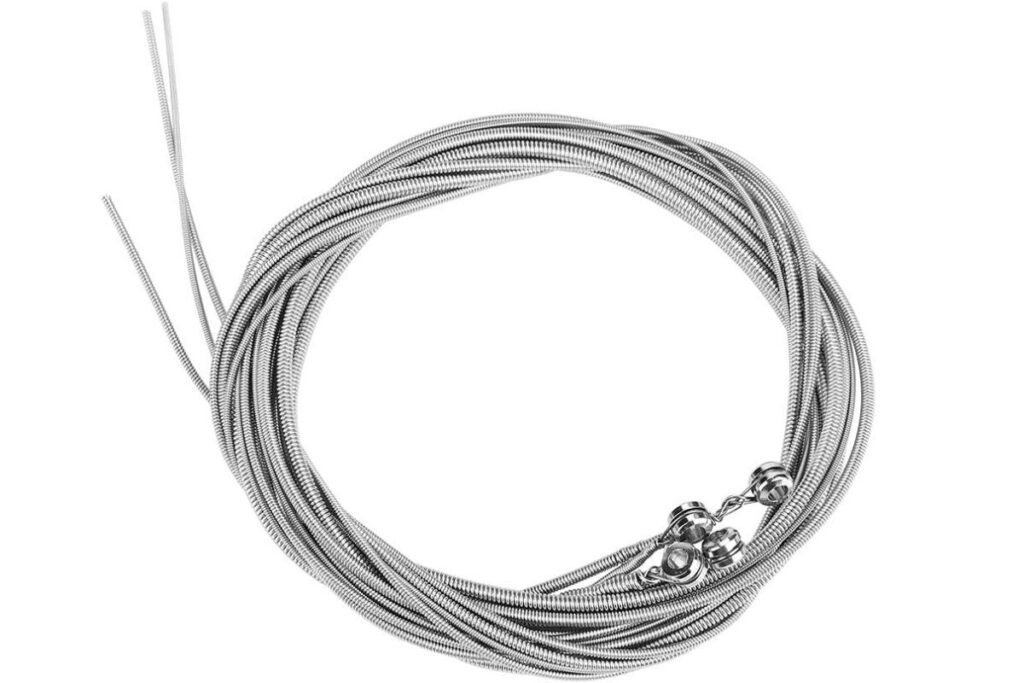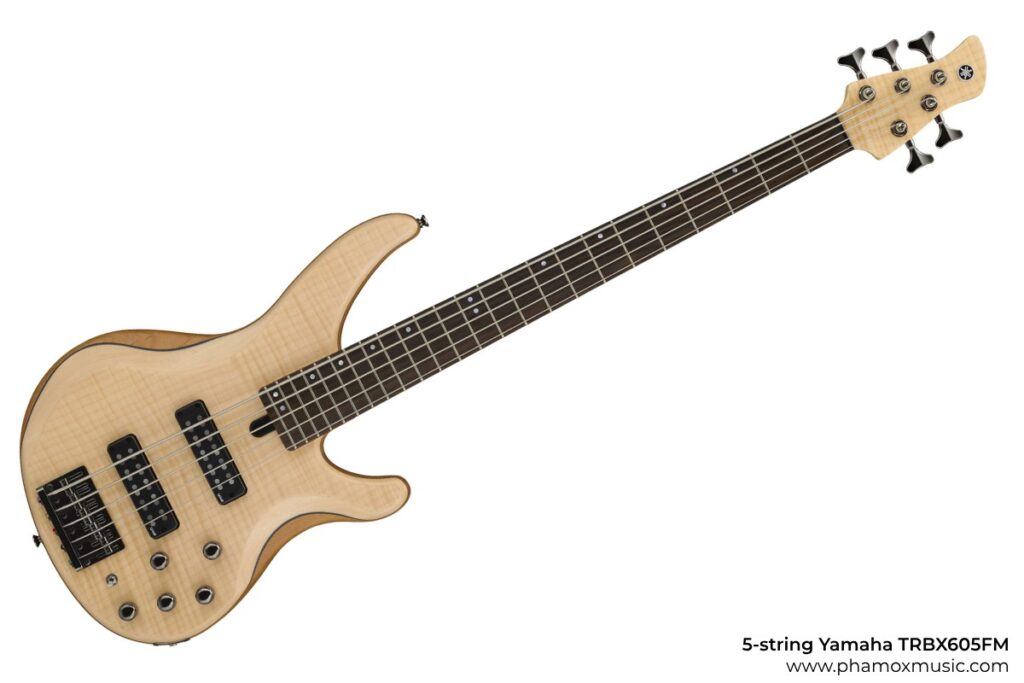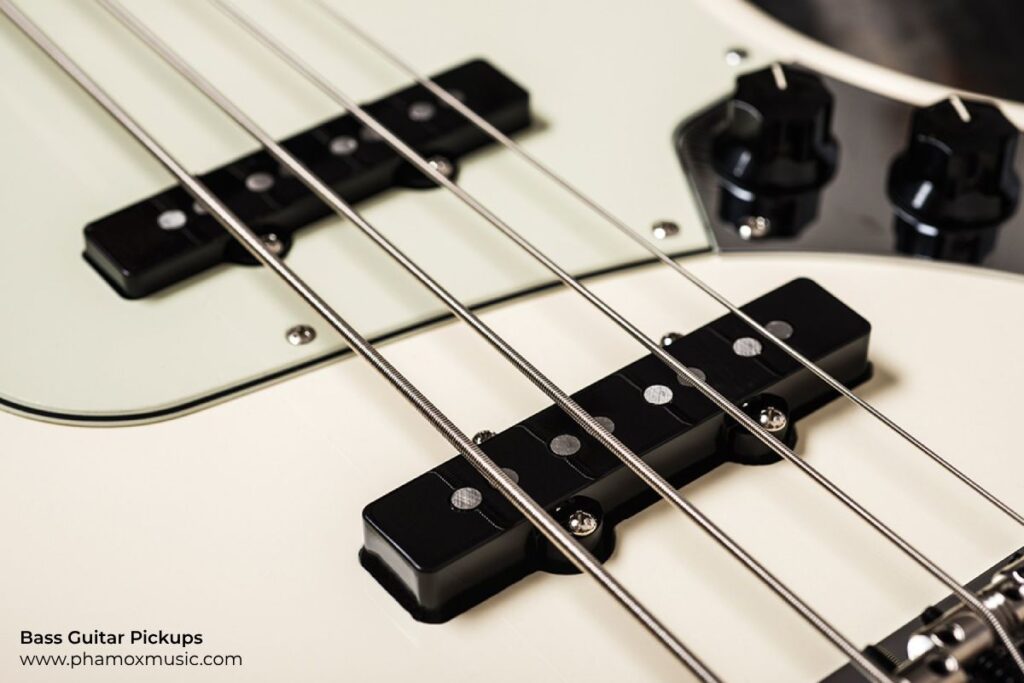All You Need To Know About Bass Guitar

Bass Guitar
Among the world’s lowest-pitched musical instruments, the bass guitar holds a prominent place as a formidable and essential member of the family.
Also known as the electric bass or simply the bass, this instrument is electronically amplified and produces the deepest tones among stringed musical instruments.
Typically equipped with four to eight sturdy strings, the bass guitar shares a similar appearance and build with both electric and acoustic guitars.
However, it distinguishes itself through its notably lengthy neck and scale length, the distance between the nut and the bridge.
While the bass guitar can be played using fingers or a pick, it is primarily categorized as a plucked string instrument.
I’m sure you’re eager to learn more about this lowest-pitched stringed instrument.
Not to worry! In this beginner-friendly guide, we’ll embark on a journey through the history, structure, and fundamentals of the bass guitar, including its essential principles.
What is a Bass Guitar?
The bass guitar is a musical instrument with plucked strings specially crafted to create deep, low-pitched sounds.
It’s primarily played with fingers, a thumb, or a pick. Sound is produced when the metal bass strings vibrate over one or more magnetic pickups, although non-magnetic pickups are occasionally used too.
These pickups then send a signal through an instrument cable into an amplifier, allowing the bass to be heard at various volumes.
Due to its low-pitched tones, the bass guitar usually lays down the foundational rhythm and harmony in a band or ensemble.
It’s a crucial element in various music genres like rock, jazz, and funk, among others.
Since the mid-1950s, the bass guitar has largely taken over the role of the double bass in popular music.
While most bass guitars feature four strings, some players prefer models with five to eight strings.
The History of the Bass Guitar

The bass guitar has a fascinating history that spans over a century. The precursor to the modern bass guitar was the double bass, a large, upright instrument used in orchestras and jazz ensembles.
In the late 19th century, innovations like the “bass violin” and the “bull fiddle” attempted to create smaller, more portable versions of the double bass.
The concept of an electric bass guitar emerged in the 1930s. American musician and inventor Paul Tutmarc is credited with creating one of the earliest known models, the Model 736 Bass Fiddle, in 1935. It had four strings and was electrically amplified.
In the 1950s, Leo Fender and George Fullerton developed the first mass-produced electric bass guitar.
This led to the creation of the Precision Bass (P Bass) by Fender in 1951, which became immensely popular.
In the late 1950s and early 1960s, other companies like Gibson, Rickenbacker, and Höfner began producing their own bass guitars, introducing a variety of designs and features.
The Jazz Bass, introduced by Fender in 1960, featured a thinner neck and two single-coil pickups, offering a wider tonal range.
The 1960s and 1970s saw a burst of creativity and experimentation.
Companies like Ampeg introduced fretless basses, while others like Alembic, Wal, and Music Man pioneered advancements in electronics and construction techniques.
The introduction of five-string basses with a lower “B” string and, later, six-string basses further expanded the instrument’s capabilities.
The 1980s saw the rise of active electronics and extended-range basses. Bassists like Jaco Pastorius and Victor Wooten pushed the boundaries of what could be achieved on the instrument.
In recent years, advancements in technology have led to the development of even more sophisticated bass guitars with features like multi-scale necks, extended range options, and advanced pickups.
Parts of the Bass Guitar

The bass guitar is composed of crucial components that collaborate to create its unique sound.
These components bear resemblance to those found in electric guitars, sharing many similar features.
From the body to the strings, each component plays a crucial role in creating music.
Understanding the different parts of the bass guitar provides valuable insight into how this remarkable instrument produces its distinct sound.
In this section, we will swiftly discuss the fundamental parts of the guitar.
The highlighted diagram below shows all of the main parts of the bass guitar.
The Body
The body of a bass guitar forms its main frame. It comes in different shapes and sizes, each contributing to the instrument’s overall tone.
Common materials include woods like maple, mahogany, and ash.
The body houses vital components such as the pickups and controls.
Pickups
Located on the body of the bass guitar, pickups are like the ears of the instrument.
They capture the vibrations of the strings and convert them into electrical signals.
These signals are then sent to an amplifier, where they are transformed into audible sound.
Neck and Fretboard
The neck is the long, slender part that extends from the body of the bass.
It holds the fretboard, which is marked with metal strips called frets.
By pressing down the strings on these frets, musicians can change the pitch of the notes produced.
Headstock and Tuning Pegs
At the end of the neck, you’ll find the headstock. This is where the tuning pegs are located.
These pegs allow the bassist to adjust the tension of the strings, ensuring they produce the correct notes when played.
Strings
The strings are perhaps the most recognizable part of the bass guitar.
They run along the length of the instrument, from the headstock to the body.
Most bass guitars have four strings, but some have five or even six for extended range.
The thickness and material of the strings greatly influence the bass’s sound.
Bridge
The bridge is the anchor point for the strings on the body of the bass.
It helps maintain the correct tension and also affects the tone of the instrument.
Some basses have fixed bridges, while others have adjustable ones for fine-tuning.
Controls
On the body of the bass, you’ll find various knobs and switches.
These control elements allow the musician to adjust the volume, tone, and sometimes even the pickup selection.
This versatility empowers bassists to shape their desired sound.
Strap Buttons
To play the bass comfortably, a strap is often used.
Strap buttons are attached to the body of the instrument, providing secure points for the strap to be connected.
The Strings of a Bass Guitar
The strings on a bass guitar can vary from one instrument to another, often depending on the player’s preference.
In general, bass guitar strings consist of two main components: a core and a winding.
The core is a wire that runs through the center of the string and is typically made of materials like steel, nickel, or an alloy.
The winding, on the other hand, is an additional wire that wraps around this core.
Bass guitar strings differ based on the materials and the shape of the winding.

There are several common variants, including roundwound, flatwound, and halfwound (sometimes called groundwound). We also have coated, tapewound, and taperwound, which is distinct from tapewound.
Roundwound and flatwound strings have windings with circular and rounded-square cross-sections, respectively.
Halfround strings are a hybrid between the two. Coated strings have a synthetic layer applied to their surface, while tapewound strings feature a metal core with a non-metallic winding.
Taperwound strings have a unique tapered end where the inner core is exposed and rests on the bridge saddle without any additional windings.
The choice of winding style significantly impacts the instrument’s sound, and certain winding types are often favored for specific music genres.
In contrast, flatwound strings boast a wrap wire with a smooth, flat surface, providing a pleasant, friction-free feel and enabling swift movement along the strings.
On the other hand, roundwound strings maintain the ridges of the wrap wire as it winds around the core wire, resulting in increased friction under the fingers.
As a result, flatwound strings are known for their smooth, warm tones, while roundwound strings generally produce a brighter, more vibrant sound.
Note
When it comes to selecting the best bass guitar strings, there are a wide array of excellent options available, regardless of the type of bass you play.
However, given the multitude of choices, it’s essential to find the strings that best match your unique sound and playing style.
How Many Strings Does a Bass Guitar Have?
Most bass guitars come with four strings. However, the models with five, six, seven, or even eight strings are available in the market.
Typically, the majority of bass players find comfort in the classic four-string bass.
The next popular choice is the five-string bass, favored by one out of every three bassists.
Bass guitars with six or more strings are rarer and tend to be favored by a smaller group of players.
You can identify a 6-string bass by its wider fretboard, thicker strings, and larger size.
In reality, most bassists find that four strings are more than sufficient. Some may even thrive with just three, and a few are perfectly content with two.
This is because most bass lines reside in a lower register. Having four strings strikes a balance where most bassists don’t feel restricted by having too few strings.
While an extra-high string might make certain things easier, it wouldn’t fundamentally change the playability of bass lines.
Opting for a 5-string or 6-string is a great choice if you’re seeking more melodic possibilities or exploring heavier music genres.
Tuning of the Bass Guitar Strings
When we talk about bass guitars, one important thing to know is how they are tuned.
Tuning means setting the pitches for the different strings on the bass. These pitches are like musical notes.
Most bass guitars have four strings, and they are usually tuned in a way that’s similar to regular guitar strings. This helps players create different sounds and melodies.
In standard tuning for a four-string bass, the strings are set in this order, from the lowest sound to the highest: E’, A’, D, and G.
The highest string, called the G string, creates a deep sound that is an octave and a fourth below middle C.
This tuning (that is, E1–A1–D2–G2) is the same as that of the double bass, a larger instrument.
This means:
The very highest string on the bass, which is also known as the 1st string, is tuned to a note called G2. This string is called the G string.
Moving down, the second string of the bass is tuned to a note called D2, and it’s called the D string.
The third string of the bass is tuned to a note called A1, and it’s called the A string.
Finally, the lowest string on the bass, also known as the 4th string, is tuned to a note called E1. This string is called the E string.
Tuning of 5-String and 6-String Bass

Some bass guitars have an extra one or two strings, which gives more options for different sounds.
This additional string can be tuned to a low note like B or even higher to C.
If a bass has this extra fifth string, it’s usually set to a very low note called B0.
This creates a deep and rich sound. But if we’re talking about a six-string bass, it can make an even wider range of sounds, all the way from the note B up to C.
In this case, if there’s a sixth string, it’s typically tuned to a higher note, which is C3.
Remember, while these tuning are common, it’s important to know that the way a bass guitar is tuned can vary.
This variation depends largely on how the musician likes to play and the kind of sound they want to create.
This gives bass players a lot of room to be creative with their music!
Electric Bass Guitar Sound Production
The bass guitar creates sound when the bassist plucks its strings and makes them vibrate.
These vibrations are then transformed into electrical energy through special devices called pickups.
Next, this electrical signal travels through a cable and into an amplifier.
The amplifier boosts the strength of the signal, which enables the bass to be heard at different levels of volume.
This way, the bass can be enjoyed at just the right loudness.
Bass Guitar Pickups
The bass guitar pickups are the component of an electric bass guitar that converts string vibrations into similar electrical signals. The resulting electrical signals are then sent as input to an instrument amplifier.
Essentially, a pickup functions as a means to transform mechanical energy into electrical energy.
Typically, bass guitar pickups are affixed to the body of the guitar and positioned beneath the strings.

They consist of magnets, wire, and a container known as a bobbin. Magnetic poles are inserted into holes in the bobbin and then tightly wound with a conductive wire.
This process creates an electromagnet—this electromagnetic pickup generates a magnetic field, which, in turn, magnetizes the guitar string.
When your strings vibrate, they produce a magnetic flux, which is converted into an electrical charge through the wires that envelop the magnets.
This electrical charge then travels through your bass’s wiring, along the instrument cable, and ultimately gets transformed into sound by your amplifier.
One of the popular ways to enhance your bass’s sound is by upgrading its pickups. Installing new bass pickups can truly breathe new life into your instrument.
Tone Quality of the Bass Guitar
The quality of sound produced by a bass guitar depends on various factors.
These factors include the direction, function, and technique used to wind its pickups.
Additionally, the type of magnets used and the placement of the pickups on the instrument contribute greatly to the sound quality of the bass.
Altering these factors can change the character of a bass guitar’s tone.
Different pickup manufacturers employ unique combinations of these elements to establish their distinct tones.
Moreover, many bass guitars come equipped with controls on their bodies that allow musicians to fine-tune the mix of pickups.
This, in turn, adjusts the levels and qualities of low, mid, and high-pitched sounds.
Additionally, the use of effects pedals plays a crucial role in shaping the tone and volume of the bass.
An effects pedal is a device, often activated by a foot switch, that manipulates audio signals.
It’s typically positioned between the bass and the amplifier in the signal chain, connected to the bass by one cable and to the amplifier by a second cable.
The arrangement may change based on the type of pedal being used.
Lastly, the choice of tonewoods for the body, neck, and fingerboard of the bass also contributes to the overall tone, further shaping the final output of the electronics.
How to Play the Bass Guitar
Learning to play the bass guitar can be a fun and rewarding journey.
Whether you are aiming to join a band or simply want to play for your own enjoyment, this quick guide will walk you through the basics of playing this awesome instrument.
Getting Started with the bass Guitar
Playing any instrument requires some essential steps. Begin by familiarizing yourself with the different parts of the bass guitar: the body, neck, frets, and strings. Before you start playing your bass, you need to know how to hold the instrument.
So, begin by learning how to properly position your instrument in your hands.
Understand how to hold the instrument comfortably and get a feel for the fretboard.
Tuning Your Bass
Before you start playing, it’s crucial to ensure your bass guitar is in tune. So you need to know how to tune your bass guitar. Having the ability to accurately tune a guitar ensures that you consistently deliver your finest performance.
Mastering Basic Techniques
Plucking (or Picking): Use your fingers or a pick to strike the strings in the right way. Experiment with different techniques to find what works best for you.
Fretting: Press down on the strings against the frets to change the pitch of the notes.
Sliding: Move your fingers smoothly up or down the fretboard to create a sliding effect.
Hammer-ons and pull-offs: These techniques involve quickly transitioning between notes without re-plucking the string.
Start Playing Simple Bass Lines
Start with easy bass lines from songs you enjoy. Focus on keeping a steady rhythm and ensuring each note is clear and distinct.
Practice with songs that have a slow tempo and uncomplicated melodies.
Understanding Rhythms and Timing
Pay attention to the rhythm of the song. Use a metronome to help you stay on time.
Start slow and gradually increase the tempo as you become more comfortable.
Practicing Scales
Scales are fundamental to understanding music theory.
Begin with the major and minor scales, and practice them regularly to improve your finger dexterity.
Experimenting with Styles
The bass guitar is incredibly versatile and can be used in various musical genres.
Try playing different styles like rock, funk, blues, or jazz to discover what resonates with you.
Joining a Band or Jamming
Playing with others is a fantastic way to grow as a musician. Join a band or find fellow musicians to jam with.
This will help you improve your ability to keep time and stay in sync with other instruments.
Note
When it comes to mastering the bass guitar, seeking guidance from a skilled teacher is your best bet.
Many guitar instructors may also offer bass lessons, so don’t hesitate to inquire.
Furthermore, a proficient teacher can go beyond performance techniques, delving into music theory and composition.
This enriches your understanding of the instrument and enhances your musicality.
Additionally, with a teacher’s support, you can tailor your learning experience to suit your unique musical aspirations, ensuring a well-rounded education in bass guitar.
Before we go, remember that learning to play bass guitar takes time and practice.
Stay patient, and don’t be discouraged by initial challenges.
With dedication and persistence, you will progress and become a confident bassist.
So, pick up your bass and start making music!
Bass Guitar Care and Maintenance
Taking care of your bass guitar is a crucial responsibility for any bassist.
In this section, we will explore some essential maintenance tips that will help keep your instrument in excellent condition.
By following these steps, you’ll not only have a bass that’s ready to play but also one that will stay with you for the long haul.
Ensure Proper Storage
Securing your bass guitar in a safe spot is the first step in safeguarding it from potential mishaps in your daily routine.
It’s highly recommended to store your guitar inside a sturdy hardshell case when it’s not in use.
This protective measure ensures that accidental bumps or trips won’t result in any damage.
Additionally, it shields your guitar from direct sunlight and prevents dust and dirt buildup.
Remember, never leave your guitar in your car or garage, as extreme temperatures can harm your instrument, especially its neck.
Frequent and Routine Cleaning
Maintaining cleanliness is key. Wash your hands before handling your bass, and take short breaks between plays to avoid transferring oils.
After every session, however brief, use a microfiber cloth to wipe down your strings.
Start with the strings themselves, then move to the frets and fretboard to remove any accumulated grime.
Your bass guitar should undergo a thorough cleaning at least every three months to ensure its longevity and performance.
Maintained Tight Screws
Dedicate some time to carefully examine the various screws and nuts on your instrument to confirm that they are securely fastened.
This thorough inspection should encompass mechanical components like the machine heads, pickguard, and bridge, ensuring that everything is properly tightened.
This seemingly small yet crucial step can prevent the inconvenience of hunting for a misplaced screw in the future.
Moreover, when it comes to strap pins, this simple precaution could also spare your guitar from potential damage.
Clean the Dirty Fretboard
To maintain optimal playing conditions, cleaning the fretboard is essential.
Over time, you may notice your fingerboard drying out or accumulating dirt and grime due to various playing environments.
This is the perfect moment to clean and condition it.
Begin by removing the strings to gain full access to the fretboard.
Once you’re confident all the dirt and grime have been removed, restring your bass, tune it up, and get back to playing.
Note
By following these steps, you’ll not only preserve your instrument for years to come but also enhance its playability.
A well-maintained bass guitar is less likely to encounter issues compared to one that’s neglected.
If you hold your bass dear, treat it with the care it deserves.
Final Note
The bass guitar is a fundamental instrument in any band, known for its deep, resonant tones.
Its distinctive sound is produced by various key components working together.
These include the body, neck, and strings, each playing a vital role.
The body provides the main frame, while the neck and strings allow for the production of different notes.
A standard bass guitar typically has four strings, and each one is tuned to a specific pitch.
This means that when a musician plays a string, it produces a specific musical note. The standard tuning for a four-string bass is E’, A’, D, and G.
Additionally, pickups capture the vibrations of the strings and convert them into electrical signals, which are then transformed into sound.
This process is essential to creating the distinctive tones of the bass guitar.
I believe this article provides valuable insight into how this remarkable instrument produces its distinct tones, making it an essential part of any musical ensemble.
At Phamox Music, we go all out for exactness and honesty. For this purpose, if by any means you found any possible glitch, be it factual, editorial, or something that we need to update, kindly contact us.
If you find the information provided in this post “Bass Guitar” interesting and helpful, kindly share it with someone you know that might need it.







